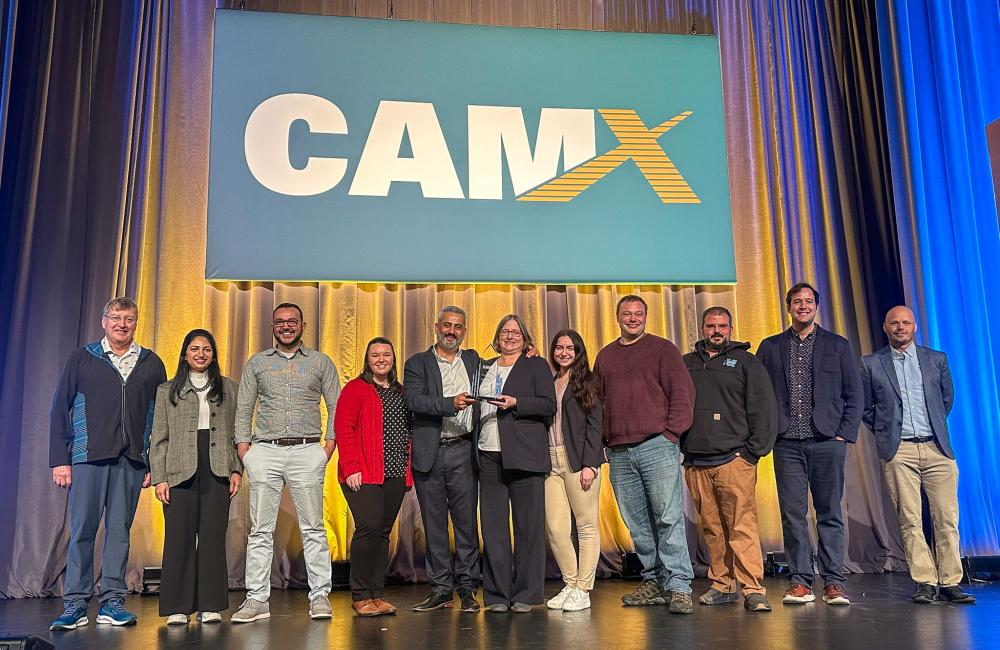SM2ART team members receive the CAMX Combined Strength Award at the Georgia World Congress Center in Atlanta. Pictured here are, from left, ORNL’s Dan Coughlin, Sana Elyas, Halil Tekinalp, Amber Hubbard, Soydan Ozcan; University of Maine’s Susan MacKay, Angelina Buzzelli, Scott Tomlinson, Wesley Bisson; and ORNL’s Matt Korey and Vlastimil Kunc. Credit: University of Maine
The Hub & Spoke Sustainable Materials & Manufacturing Alliance for Renewable Technologies, or SM2ART, program has been honored with the composites industry’s Combined Strength Award at the Composites and Advanced Materials Expo, or CAMX, 2023 in Atlanta. This distinction goes to the team that applies their knowledge, resources and talent to solve a problem by making the best use of composites materials.
The program’s team members – the University of Maine, the Department of Energy’s Oak Ridge National Laboratory, the Maine State Housing Authority, WBRC Inc. and the Maine Technology Institute – were recognized for their work in developing BioHome3D, the nation’s first additively manufactured, or 3D-printed, home made entirely from biobased materials.
The Hub and Spoke SM²ART Program is a partnership that combines UMaine’s extensive forest-derived bio-based composites expertise with ORNL’s advanced manufacturing capabilities.
The SM²ART team developed the 600-square-foot, 3D-printed single-family home at UMaine’s Advanced Structures and Composites Center, or ASCC, to help address affordable housing and labor shortages. The project also supports revitalization of the U.S. forest-products industry.
“It is a great honor to be recognized by the composites industry for our work to advance construction methods,” said Susan MacKay, senior research & development program manager at the ASCC. “We are excited to show affordable, lower-cost and sustainable housing is possible by combining automated manufacturing technology with environmentally friendly building materials.”
The fully bio-based composite material feedstock used in BioHome3D was developed by ORNL and ASCC researchers especially for large-scale additive manufacturing, or AM, processes. Locally sourced pine fibers reinforced the special grade biopolymer to enhance composite stiffness and control, improving the rheology, or flow, cooling and thermal expansion and contraction behaviors of the formulation.
By applying a technique known as finite element analysis, or FEA, to predict reactions to real-world effects, the SM²ART team anticipated composites material distortion behavior and used different printing approaches that included patented 45-degree and 90-degree printing technologies. Researchers then used the world’s largest 3D printer to create the structure’s entire volume – the roof, walls, floor and interior wall – in a single continuous print path at an average deposition rate of 120 pounds of composites per hour.
The SM2ART team’s work aligns with DOE’s Affordable Home Energy Shot, part of the DOE Energy Earthshot program that aims to decarbonize and reduce energy bills of the nation’s residential buildings by 20% within a decade. “BioHome3D could set new expectations for how homes are built in the future to enhance affordability and energy efficiency, and to address housing, sustainability and climate-change challenges,” said Soydan Ozcan, an ORNL materials scientist who leads research with UMaine. “The CAMX Combined Strength Award speaks to the confidence the industry has in the positive impacts this approach can have on consumers, the construction industry and the environment.”
Research for the BioHome3D project was performed at DOE’s Manufacturing Demonstration Facility at ORNL, a nationwide consortium of collaborators working with ORNL to innovate, inspire and catalyze the transformation of U.S. manufacturing, and ASCC at the University of Maine. These facilities are the base for the SM2ART Consortium, a nationwide group of industry and academic partners dedicated to advancing sustainable sourced biogenic resource utilization and its integration into advanced manufacturing, thereby promoting U.S. supply chain for advanced manufacturing. This collaborative initiative is carried out with guidance from DOE's Advanced Materials and Manufacturing Technologies Office, or AMMTO.
UT-Battelle manages ORNL for DOE’s Office of Science, the single largest supporter of basic research in the physical sciences in the United States. DOE’s Office of Science is working to address some of the most pressing challenges of our time. For more information, visit https://energy.gov/science.






